
Line 1, shortened to L1, coloured red and often simply called Línia vermella, is the second oldest Barcelona Metro line, after line L3. It is the longest line of the Barcelona Metro, and links L'Hospitalet de Llobregat and Santa Coloma de Gramenet. Originally operated by the independent Ferrocarril Metropolitano Transversal de Barcelona, it is today operated by Transports Metropolitans de Barcelona (TMB) and is part of the ATM fare-integrated main transport system. L1 is the only metro line in Spain to use Iberian gauge tracks, as used by most Spanish main line railways.

Fondo is a Barcelona Metro station in the municipality of Santa Coloma de Gramenet, in the northern part of the metropolitan area of Barcelona. It is served by two metro lines, L1, of which it is the northern terminus, and L9. It was built in 1992 under Camí Fondo de Badalona, in the neighbourhood of Fondo, between Carrer Dalmau and Carrer Verdi.
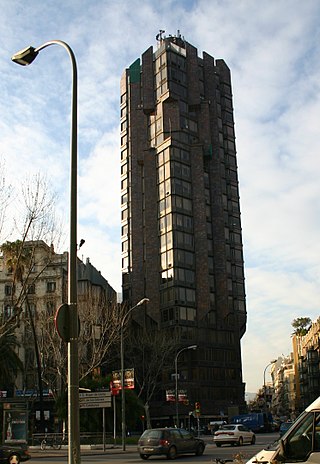
The Plaça d'Urquinaona is one of the principal squares in central Barcelona. It is officially part of Dreta de l'Eixample neighbourhood, in the Eixample district, and is located at the intersection of the Ronda Sant Pere and Carrer d'Ausiàs Marc.

Plaça de les Glòries Catalanes, most often shortened to Glòries, is a large square in Barcelona, first designed by Ildefons Cerdà to serve as the city centre in his original urban plan, but nowadays relegated to quite a secondary position. It is located in the Sant Martí district, bordering Eixample, at the junction of three of the city's most important thoroughfares: Avinguda Diagonal, Avinguda Meridiana and Gran Via de les Corts Catalanes. Currently it serves largely as a roundabout of elevated highways. However, beginning in the early 2000s, and as of 2007, revamping project for Glòries has started, which is aimed to give the square a new role in Barcelona and revitalize the northern districts of the city, under the name 22@. These plans supplement other large-scale plans in Sagrera and the Fòrum area. The first installment of this project was the construction of the controversial Torre Agbar skyscraper.

Marina is a station in the Barcelona Metro and Trambesòs tram networks, at the boundary between the Eixample and Sant Martí districts of Barcelona. It is served by TMB line L1 and tram route T4. The station is named after the nearby Carrer de la Marina, and can be accessed from Carrer dels Almogàvers, and the crossing of Carrer de la Marina with the Avinguda Meridiana. It is adapted for disabled people.

Trinitat Vella is the name of a station in the Barcelona metro network, currently served by the TMB-operated L1. It's named after the neighbourhood Trinitat Vella, in the Sant Andreu district of Barcelona, and the park of the same name. It is quite unusual in being one of the few stations with an attached building overground, which lies on the Nus de la Trinitat and links the neighbourhood with Parc de la Trinitat.
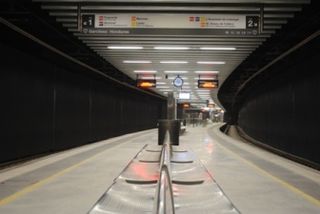
La Sagrera-Meridiana, simply known as La Sagrera, is an interchange complex underneath Avinguda Meridiana, in the Barcelona district of Sant Andreu, in Catalonia, Spain. It consists of a Rodalies de Catalunya station and three Barcelona Metro stations. The Rodalies de Catalunya station is located in the Meridiana Tunnel on the Lleida to Barcelona via Manresa railway, between Sant Andreu Arenal and Arc de Triomf, and is operated by Renfe Operadora. It is served by Barcelona commuter rail service lines R3 and R4, as well as regional rail line R12. The Barcelona Metro stations are on lines 1 (L1) and 5 (L5), as well as the northern section of line 9/10, and are operated by Transports Metropolitans de Barcelona (TMB). On the L1, the station is between Navas and Fabra i Puig, on the L5 between Camp de l'Arpa and Congrés, and on the L9/L10 between Plaça Maragall (future) and Sagrera - TAV. The station is also projected to become the terminus of the L4 once the extension from La Pau opens. A number of interurban bus services stop near the station.

Urgell is a Barcelona Metro station, named after the Carrer del Comte d'Urgell, in the Eixample district of the city of Barcelona. The station is served by line L1.
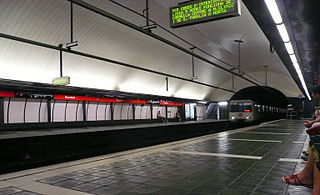
Rocafort is a Barcelona Metro station, named after the Carrer de Rocafort, in the Eixample district of the city of Barcelona. The station is served by line L1.

Plaça de Sants is a Barcelona Metro station, named after the nearby Plaça de Sants, in the Sants-Montjuïc district of the city of Barcelona. The station is served by lines L1 and L5.
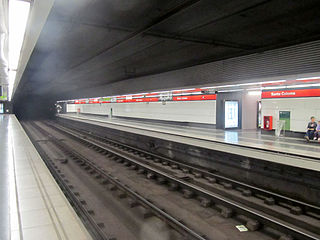
Santa Coloma is a Barcelona Metro station in Santa Coloma de Gramenet, a municipality of the metropolitan area of Barcelona. It's served by L1. It opened in 1983 and is located under Passeig Llorenç Serra. Platforms are 99 m (325 ft) long.
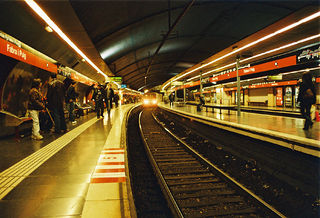
Fabra i Puig is a Barcelona Metro station, on L1, located in the Sant Andreu district of Barcelona, below Avinguda Meridiana between Carrer de Concepció Arenal i Passeig de Fabra i Puig. It opened in 1954, with the extension of the aforementioned line from Sagrera to this station. Passengers can commute here for the Renfe-operated Sant Andreu Arenal railway station. It's named after Passeig de Fabra i Puig, one of the main thoroughfares of the area.
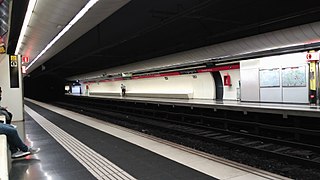
Hostafrancs is a Barcelona Metro station, named after the Hostafrancs neighbourhood, in the Sants-Montjuïc district of the city of Barcelona. The station is served by line L1. The station's name is still occasionally written as Hostafranchs, following the old Catalan spelling, chiefly in Spanish-language contexts.
Rambla Just Oliveras is a Barcelona Metro station, in the L'Hospitalet de Llobregat municipality of the Barcelona metropolitan area, and named after the nearby street of Rambla Just Oliveras. The station is served by line L1, and is adjacent to the L'Hospitalet de Llobregat railway station, the main Rodalies Barcelona and mid-distance transport hub in the area.
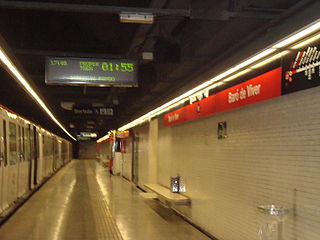
Baró de Viver is a station of the Barcelona Metro, in the Baró de Viver area of Sant Andreu, a northern district of Barcelona. It is operated by Transports Metropolitans de Barcelona (TMB) and served by L1. The station opened in 1983 as the line grew from its terminus in Torras i Bages towards the municipality of Santa Coloma de Gramenet. It is located under the southern side of the busy Nus de la Trinitat, next to the Besòs river bank.

Selva de Mar is a Barcelona Metro and Trambesòs station located in Poblenou, Sant Martí district, Barcelona. It's located under carrer de Pujades, between carrer de Provençals and carrer de Selva de Mar - where the alternative entrance is. The metro station, served by L4, was opened in 1977 as part of the elongation of the line from Barceloneta. The tramway station is a 2004 addition, opened that year along with other stations in the T4 route.
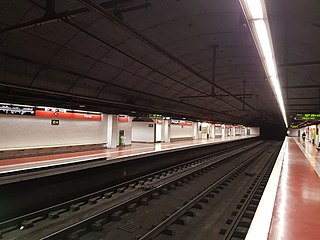
Florida is a Barcelona Metro station, in the L'Hospitalet de Llobregat municipality of the Barcelona metropolitan area, and named after the nearby La Florida neighbourhood. The station is served by line L1.
Hostafrancs is a neighbourhood in the Sants-Montjuïc district of Barcelona, Catalonia, Spain.

Torrassa is a Barcelona Metro station, in the L'Hospitalet de Llobregat municipality of the Barcelona metropolitan area, and named after the nearby La Torrassa neighbourhood. The station is served by line L1, line L9 and line L10.



















